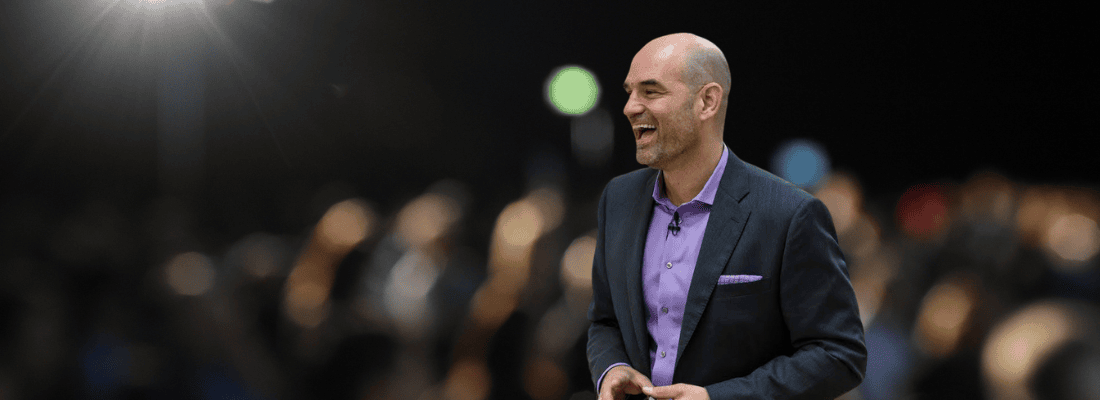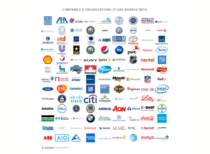Keynote Speeches
During times of uncertainty, the human brain defaults to protection and not risk. But taking risks–trying new ways of doing things, naming inconvenient truths, having feedback conversations – is exactly what’s needed during times of change.
In addition, becoming risk averse is the opposite of what is needed to operate at the speed required to adapt to the challenges organizations face today. The key word here is faster.
This focus on speed has spread to every industry and every function of a company: product development, supply chain, technology and tools, sales and marketing, digital transformation, everything. Organizations today don’t need economies of scale; they need economies of speed.
What does that mean for you as a leader? You—and your organization—must take more risks just to keep up. Every time you back away from a risk you know you should be taking, you slow down your organization and this impairs your ability to adapt to the uncertain, changing environment you face.
In this powerful program, you will learn from our proprietary study of 34,000 people (to be published in Harvard Business Review in 2025) that found a quantifiable gap between the risks people know in their gut they should be taking and the actual risks they take. In other words, people don’t have the full conversation they want to have, or they put off making the hardest decisions. In these and other situations we’ve studied, people always wish they’d acted and taken the risk sooner. This research showed the gap is 7.56%. We named this gap, the Last 8%.
Specifically, you will learn:
- What the norms are on a team that slows down their speed of execution and ability to deal with uncertainty. In a study of 72,000 people, we found 67% of teams do not have a culture that is conducive to the amount of risk required today. What did we learn about the other 33% that can help you move at speed and be successful?
- What one thing in common the top performers in the world we have worked with have, whether Olympic athletes or Navy Seals, who need to manage their emotions in life-or-death situations, or employees and leaders at fortune 500 companies who need to deliver results in high stress Last 8% situations that allowed them to flourish in uncertain environments?
- Concrete tools to manage your brain so you can lead more effectively under pressure in your Last 8% moments
- How to create a culture on your team that enables people to operate and execute at the speed required to deal with the challenges and uncertainty you face.
You need to move fast, adapt to a changing environment, and deliver performance, yet your team is moving too slow when it comes to making tough decisions and are avoiding the more challenging conversations that drive results.
What is at the heart of high performance is culture. Unfortunately, most leaders misunderstand culture; they believe culture exists across the organization; it doesn’t. It exists primarily on teams. Second, they see culture as something that should be owned by the CEO and CHRO, believing it is their job to build the culture across the organization; it isn’t. Most CEO’s and CHRO’s get so overwhelmed when they think of tackling culture, that they avoid it and allow culture to be built haphazardly, which means that good people leave, and goals are not met.
In this powerful virtual or live keynote, your team will learn the results from our study of 7,500 leaders that puts your managers and people leaders at the center of building your culture. Your people will learn specific tools to own the culture on their team in the critical moments, the Last 8%, that creates culture. The Last 8% are those tougher conversations and decisions that many people struggle with and avoid. When leaders feel agency and have skills to lean into the difficult, they build a high-performance culture that becomes a powerful force in your organization.
In this powerful program, your team will learn:
- What the two pillars of a high performing culture are: High Connection (psychological safety) and High Courage (ability to do hard things skillfully)
- How to build the culture on their team with our proprietary approach of Model & Own
- Specific tools to connect and coach their people to be their best in Last 8% Situations
- How to influence & engage others who are at a distance and create the conditions to keep the best and brightest
JP Pawliw Fry on The Last 8% Culture – NSB speaker for more insights on this topic
Your people are facing the biggest challenge of their careers, yet most continue to rely on their IQ and technical skills to manage through it all. It’s not enough.
To survive, your organization needs to be agile in the midst of change and challenge, and see opportunities where others do not. Your team needs to learn how to work effectively with others who are, themselves, under pressure.
In this powerful program, your team members will learn:
- Specific tools learned from working with high performers under pressure in the NFL, NBA, Olympic teams, Navy SEALs, Goldman Sachs, Intel, among others, to be more adaptable, resilient, collaborative and opportunistic
- How to manage their brain so they can think, perform and lead effectively under pressure
- The single most important daily habit that increases focus and decreases burnout
- Strategies to help their teams perform in the face of the pressure they face
This program is based on a 12,000-person study conducted for our New York Times best-selling book, Performing Under Pressure, which is available in 65 countries.
This session can be delivered for sales people and sales teams, focusing on helping them harness emotional intelligence to deal with pressure, build stronger relationships with their clients, collaborate internally and deal with the setbacks and uncertainty that sales people must overcome to be successful.
Our research has found that most people are relatively effective at getting to 92% of what they want to say in a feedback conversation. But when they get to the Last 8% of what they really want to say–the hardest part of the feedback they want to give–the part of the conversation that has consequences for the other person, they sense the potential emotional impact this feedback might have, and they back off, avoiding giving the feedback that’s needed.
This creates significant challenges for the other person: not only do they not know how or where they stand, which increases their anxiety, but they are also not given a chance to improve. Worse, they feel less psychologically safe and emotionally connected, which diminishes their performance.
The goal of this program is to give your people the insight and tools to manage their emotions to get to the Last 8% of what they want to say in any feedback conversation. The good news is that there is a burgeoning science of how to give and receive feedback that anyone can learn. It starts by becoming a ‘student of human behavior’, understanding the brain under pressure, and learning the concrete skills needed to give feedback in a way where the other person can hear it.
In this powerful program, your people will learn:
- What The Last 8% is and why it provides the biggest opportunity to learn, grow and boost their performance.
- How the brain reacts under pressure and why that is at the heart of why people avoid giving Last 8% feedback.
- Self-awareness: what their habitual way of reacting to receiving feedback is and why that matters as a signal to the other person that they are open to receiving this important feedback.
- How to start a Last 8% feedback conversation: most people do not know where to start, which causes anxiety. Along with trying to be perfect, this stops them from beginning this important conversation.
- What the key components are to building an environment of high psychological safety, and why it matters to innovation.
Platform Plus Presentations
Unique formats and ways to connect with audiences.
- JP will use the data to customize the program for your unique needs.
- By taking the assessment, it prepares the learner’s brain to think about their impact and behavior ahead of time.
- JP will tailor/customize the keynote with key results from the survey to address what matters most to the participants
- Post program, JP will share any information we didn’t see fit for a wider audience but believe will help you move forward with building culture and lead your teams more effectively
Changing or improving a culture in an organization is not easy. Often, initiatives to improve culture fail because the scope was too big from the start – they become too costly, too time intensive and weren’t connected to strategy. As a result, your teams can often become cynical and unreceptive to the subject of culture. Unfortunately, when culture doesn’t grow by design, it grows by default.
Our approach is radically different.
It starts with understanding that culture doesn’t exist across an organization, it exists on teams. For this reason, our goal is to equip your people leaders with the insight and skills to take ownership and build culture on their own team. It’s a powerful thing when people leaders have agency to build culture on their teams.
Culture is not created by choosing a set of values that people rarely remember; instead, it is built by what happens in difficult, pressure-filled moments, what we call the Last 8%. Our approach equips your managers to see difficult situations differently – not as something to avoid, but as an opportunity to create culture on their team. Our systematic approach typically takes six months, allowing you to build your culture in months, not years.
Our approach establishes a high-performance, Last 8% culture built on High Connection and High Courage, owned by each team leader. The result? People deliver results and stay because their needs are being met, they are more emotionally.
In this highly interactive session focuses on building a high-performance culture to elevate the organization to the next level of performance and execution. It includes a blend of insights and tools to help your leaders learn how to build a Last 8% Culture on their own teams. In this session, you leaders will:
-Discuss current and aspirational culture of their team.
-Review the results of the Last 8% --Culture assessment to see where their strengths are and opportunities to improve.
-Learn the key pillars of a high-performing culture (Connection and Courage)
-Understand how to build a culture that boosts performance and supports the evolving strategy.
-Establish commitment to a long-term focus on Last 8% Culture.
-Outline the role of each senior leader to own, assess and model culture on their own team.
Includes: -3-4 hour workshop
-Pre-call with key stakeholders to understand the audience and align content with expected outcomes
-Pre-work Last 8% Culture assessment
-Post-Call to collect feedback and discuss sustainment
Target Audience: Managers, Teams, and Individuals












Similar Speakers 123